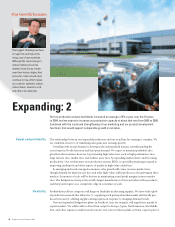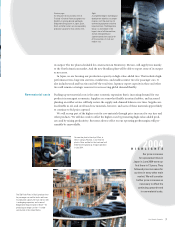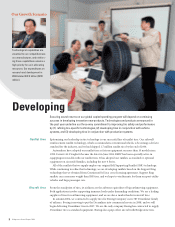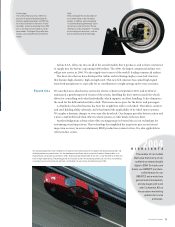Bridgestone 2004 Annual Report Download - page 18
Download and view the complete annual report
Please find page 18 of the 2004 Bridgestone annual report below. You can navigate through the pages in the report by either clicking on the pages listed below, or by using the keyword search tool below to find specific information within the annual report.
16
Bridgestone Annual Report 2004
Operating income in our European operations climbed 43%, to ¥22.0 billion ($211 mil-
lion), on a 12% increase in sales, to ¥325.6 billion ($3.1 billion). We more than offset the adverse
effect of rising raw material costs on earnings by achieving unit sales growth, by raising tire prices,
and by successfully promoting high-performance tires and otherwise improving our sales portfolio.
Our European unit sales increased in passenger car tires and in truck and bus tires. Those increas-
es comprised modest gains in passenger car tires in the replacement market and in the original
equipment market, a double-digit gain in truck and bus tires in the original equipment sector, and a
small decline in truck and bus replacement tires, which resulted mainly from supply constraints.
Economic growth in Europe was stronger than expected, supported by export demand. The EU
reports that overall economic growth in its 15 member nations was 2.3% in 2004, compared with an
earlier projection of 2.0%. Tire demand generally reflected the modest economic expansion.
Supply constraints, a problem for us everywhere, were especially severe in Europe. Our European
operations addressed that challenge by increasing output at existing plants and by focusing on high-
value-added products.
We project further sales growth in 2005 at our principal European subsidiary, Bridgestone
Europe NV/SA. A decline in operating income appears unavoidable, however, because of the
rising cost of raw materials.
The Poznan Plant, in Poland, became the first Bridgestone plant outside Japan to produce runflat
tires in December 2004. Production at that plant centers on high- and ultrahigh-performance tires
for passenger cars, and expanded output there is part of our strategy for strengthening our supply
capacity in Europe. We are also expanding our Bilbao Plant, in Spain, which produces truck and bus
tires. And we are studying the possibility of building another tire plant in eastern Europe.
Independent capabilities in producing raw materials fortify our tire manufacturing in Europe,
too. Those capabilities include production lines for steel cord in Italy and for textile cord in Spain.
The First Stop network of independent retailers is the cornerstone of our European marketing effort
in passenger car tires. Those dealers assert a unified identity in a network that extends throughout
Left and below:
First Stop is a fast-growing network of affiliat-
ed retailers who serve European passenger
car owners with tire sales and service. The
Truck Point network of independent dealers
provides sales and service for trucks and
buses—including 24-hour road service—
all across Europe. The network supports
our strategy of developing business with
pan-European fleet operators.
Regional Review: Europe
Expanded production
Marketing initiatives
Success in Formula One (F1) competition has
raised our profile greatly in the European mar-
ket. Bridgestone tires have carried drivers and
teams to seven consecutive season titles in F1
racing.
























